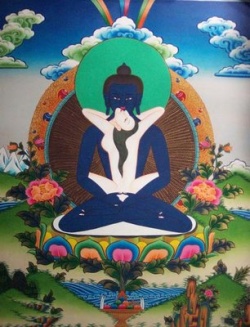Trikaya doctrine
trikaya doctrine. Doctrine of the three bodies (better, levels of manifestation) of the Buddha, developed within Mahayana Buddhism. The three kaya are
(1) Dharmakaya (Skt., = Tib. chöku), the ultimate nature of Buddhahood as inherent in all phenomena and beings, symbolized by the Buddha-forms Vajradhara in the New Tantra and Samantabhadra in the Old Tantra;
(2) Sambhogakaya (Skt., = Tib. longchöku), the level of visionary manifestation of Buddhahood, as with the yidam or Tantric deities such as Avalokiteshvara, Amitabha or Tara;
(3) Nirmanakaya (Skt., = Tib. tulku), the physical form or emanation of Buddhahood, such as the historical Buddha, Shakyamuni. See also Tulku.
- REDIRECTTrikaya
Source
http://users.hunterlink.net.au/~mbbgbs/Geoffrey/budgloss.html
